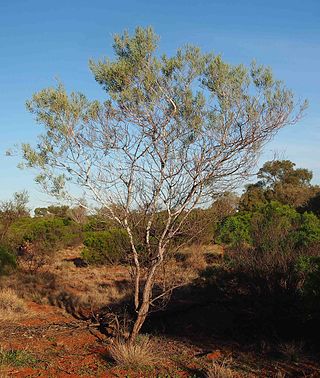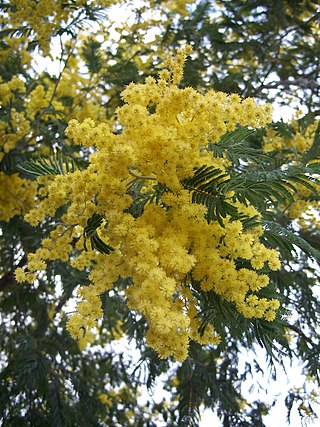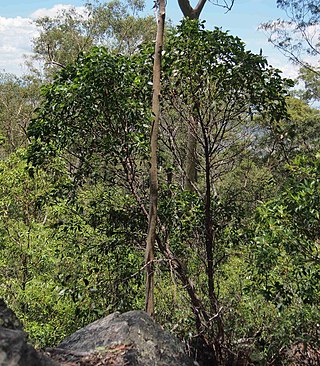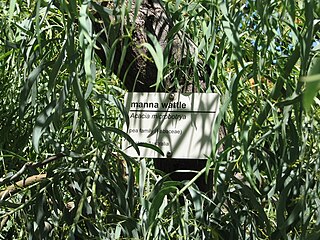
Acacia kempeana, commonly known as wanderrie wattle, witchetty bush or granite wattle, is a shrub in subfamily Mimosoideae of family Fabaceae that is endemic to arid parts of central and western Australia.

Acacia murrayana is a tree in the family Fabaceae. It has numerous common names, including sandplain wattle, Murray's wattle, fire wattle, colony wattle and powder bark wattle, and is endemic to arid areas in every mainland state except Victoria.

Acacia melanoxylon, commonly known as the Australian blackwood, is an Acacia species native to south-eastern Australia. The species is also known as blackwood, hickory, mudgerabah, Tasmanian blackwood, or blackwood acacia. The tree belongs to the Plurinerves section of Acacia and is one of the most wide-ranging tree species in eastern Australia and is quite variable mostly in the size and shape of the phyllodes.

Acacia dealbata, the silver wattle, blue wattle or mimosa, is a species of flowering plant in the legume family Fabaceae, native to southeastern Australia in New South Wales, Victoria, Tasmania, and the Australian Capital Territory, and widely introduced in Mediterranean, warm temperate, and highland tropical landscapes.

Acacia longifolia is a species of Acacia native to southeastern Australia, from the extreme southeast of Queensland, eastern New South Wales, eastern and southern Victoria, southeastern South Australia, and Tasmania. Common names for it include long-leaved wattle, acacia trinervis, aroma doble, golden wattle, coast wattle, sallow wattle and Sydney golden wattle. It is not listed as being a threatened species, and is considered invasive in Portugal, New Zealand and South Africa. In the southern region of Western Australia, it has become naturalised and has been classed as a weed due to its out-competing indigenous species. It is a tree that grows very quickly, reaching 7–10 m in five to six years.

Acacia penninervis, commonly known as mountain hickory wattle, or blackwood, is a perennial shrub or tree is an Acacia belonging to subgenus Phyllodineae, that is native to eastern Australia.

Acacia pravissima, commonly known as Ovens wattle, Oven wattle, wedge-leaved wattle and Tumut wattle, is a species of flowering plant in the legume family Fabaceae. It is an evergreen shrub native to Victoria, the South West Slopes and Southern Tablelands of New South Wales, Australia.

Acacia prominens is a shrub or tree in the genus Acacia native to New South Wales, Australia.

Acacia tumida, known colloquially as pindan wattle, spear wattle or wongai, is a species of Acacia native to northern and western Australia.

Acacia flavescens, also known as the red wattle, yellow wattle or primrose ball wattle, is a tree in the genus Acacia native to eastern Australia.

Acacia burkittii is a species of wattle endemic to Western Australia, South Australia and western New South Wales, where it is found in arid zones, and is a perennial shrub in the family Fabaceae. Common names for it include Burkitt's wattle, fine leaf jam, gunderbluey, pin bush and sandhill wattle. It has also been introduced into India. Previously this species was referred to as Acacia acuminata subsp. burkittii, but is now considered to be a separate species. It grows in mallee, eucalypt and mulga woodland or shrubland, often on sandhills.

Acacia anceps, commonly known as Port Lincoln wattle or the two edged wattle, is a species of flowering plant in the family Fabaceae and is endemic to coastal areas of south-western Australia. It is a bushy, spreading shrub with glabrous branchlets angled at the ends, elliptic to lance-shaped phyllodes with the narrower end towards the base, spherical heads of 50 to 130 golden-yellow flowers, and narrowly oblong pods up to 60 mm (2.4 in) long.

Acacia iteaphylla, commonly known as Flinders Range wattle, Port Lincoln wattle, winter wattle and willow-leaved wattle, is a shrub belonging to the genus Acacia and the subgenus Phyllodineae that is endemic to South Australia.

Acacia merrallii, commonly known as Merrall's wattle, is a shrub belonging to the genus Acacia and the subgenus Phyllodineae that is endemic to south western and southern Australia.

Acacia microbotrya, commonly known as manna wattle or gum wattle, is a shrub or tree belonging to the genus Acacia and the subgenus Phyllodineae that is native to Western Australia.

Acacia ancistrophylla is a species of flowering plant in the family Fabaceae and is endemic to southern Australia. It is a dense, rounded shrub, with lance-shaped phyllodes with the narrower end towards the base, spherical heads of yellow flowers, and linear pods up to 40 mm (1.6 in) long.

Acacia sericophylla is a shrub or tree commonly known as the desert dogwood, desert oak or cork-bark wattle. To the Indigenous Australian people of the Pilbara, the Nyangumarta peoples, it is known as Pirrkala. The species is of the genus Acacia and the subgenus Plurinerves.

Acacia calamifolia, commonly known as wallowa or reed-leaf wattle, is a shrub or tree belonging to the genus Acacia and the subgenus Phyllodineae endemic to south eastern parts of Australia.

Acacia provincialis, commonly known as swamp wattle or wirilda or water wattle or perennial wattle, is a tree or shrub belonging to the genus Acacia and the subgenus Phyllodineae native to southern and south eastern Australia.

Acacia oraria, also commonly known as coastal wattle, is a shrub of the genus Acacia and the subgenus Plurinerves that is endemic to an area along the northeastern coast of Australia and on the islands of Flores and Timor.

























